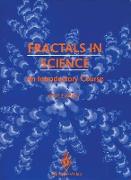- Start
- Fractals in Science
Fractals in Science
Angebote / Angebote:
Nature is full of spidery patterns: lightning bolts, coastlines, nerve cells, termite tunnels, bacteria cultures, root systems, forest fires, soil cracking, river deltas, galactic distributions, mountain ranges, tidal patterns, cloud shapes, sequencing of nucleotides in DNA, cauliflower, broccoli, lungs, kidneys, the scraggly nerve cells that carry signals to and from your brain, the branching arteries and veins that make up your circulatory system. These and other similar patterns in nature are called natural fractals or random fractals. This chapter contains activities that describe random fractals. There are two kinds of fractals: mathematical fractals and natural (or random) fractals. A mathematical fractal can be described by a mathematical formula. Given this formula, the resulting structure is always identically the same (though it may be colored in different ways). In contrast, natural fractals never repeat themselves, each one is unique, different from all others. This is because these processes are frequently equivalent to coin-flipping, plus a few simple rules. Nature is full of random fractals. In this book you will explore a few of the many random fractals in Nature. Branching, scraggly nerve cells are important to life (one of the patterns on the preceding pages). We cannot live without them. How do we describe a nerve cell? How do we classify different nerve cells? Each individual nerve cell is special, unique, different from every other nerve cell. And yet our eye sees that nerve cells are similar to one another.
Folgt in ca. 5 Arbeitstagen
